Abstract
X;autosome translocations in females with Duchenne muscular dystrophy (DMD) provide an opportunity to study the mechanisms responsible for chromosomal rearrangements that occur in the germ line. We describe here a detailed molecular analysis of the translocation breakpoints of an X;autosome reciprocal translocation, t(X;5)(p21;q31.1), in a female with DMD. Cosmid clones that contained the X-chromosome breakpoint region were identified, and subclones that hybridized to the translocation junction fragment in restriction digests of the patient's DNA were isolated and sequenced. Primers designed from the X-chromosomal sequence were used to obtain the junction fragments on the der(X) and the der(5) by inverse PCR. The resultant clones were also cloned and sequenced, and this information used to isolate the chromosome 5 breakpoint region. Comparison of the DNA sequences of the junction fragments with those of the breakpoint regions on chromosomes X and 5 revealed that the translocation arose by nonhomologous recombination with an imprecise reciprocal exchange. Four and six base pairs of unknown origin are inserted at the exchange points of the der(X) and der(5), respectively, and three nucleotides are deleted from the X-chromosome sequence. Two features were found that may have played a role in the generation of the translocation. These were (1) a repeat motif with an internal homopyrimidine stretch 10 bp upstream from the X-chromosome breakpoint and (2) a 9-bp sequence of 78% homology located near the breakpoints on chromosomes 5 and X.
Full text
PDF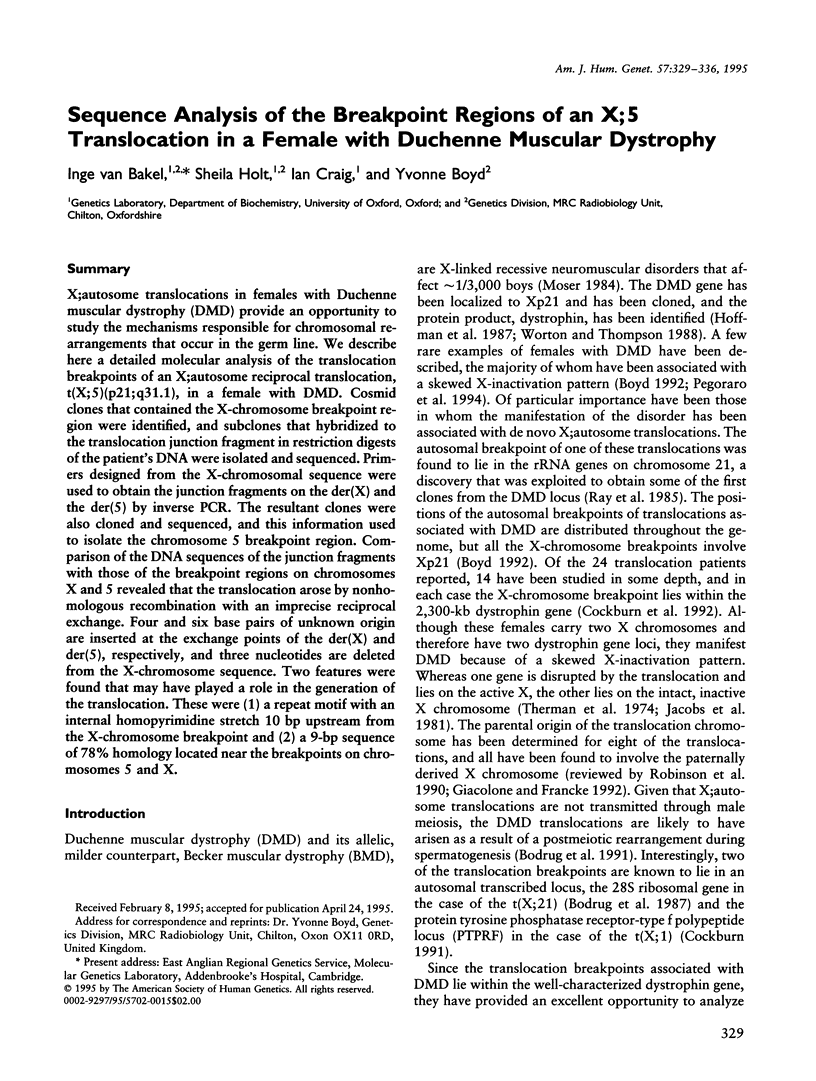
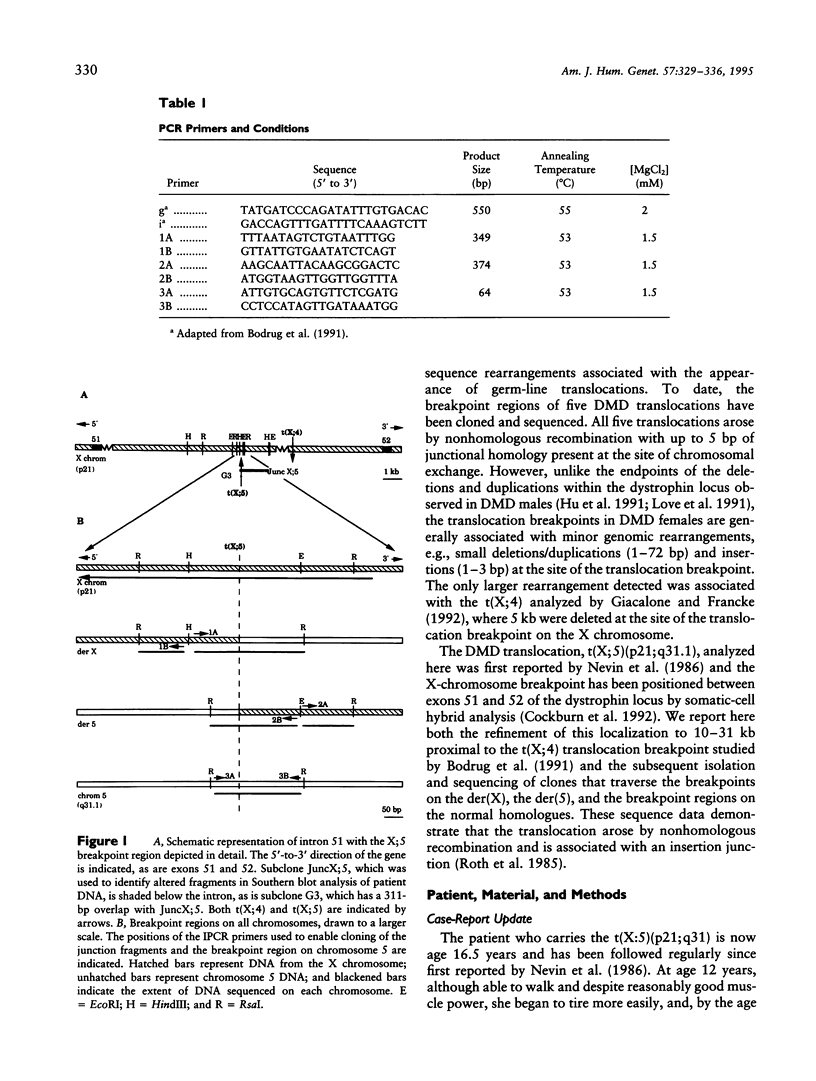
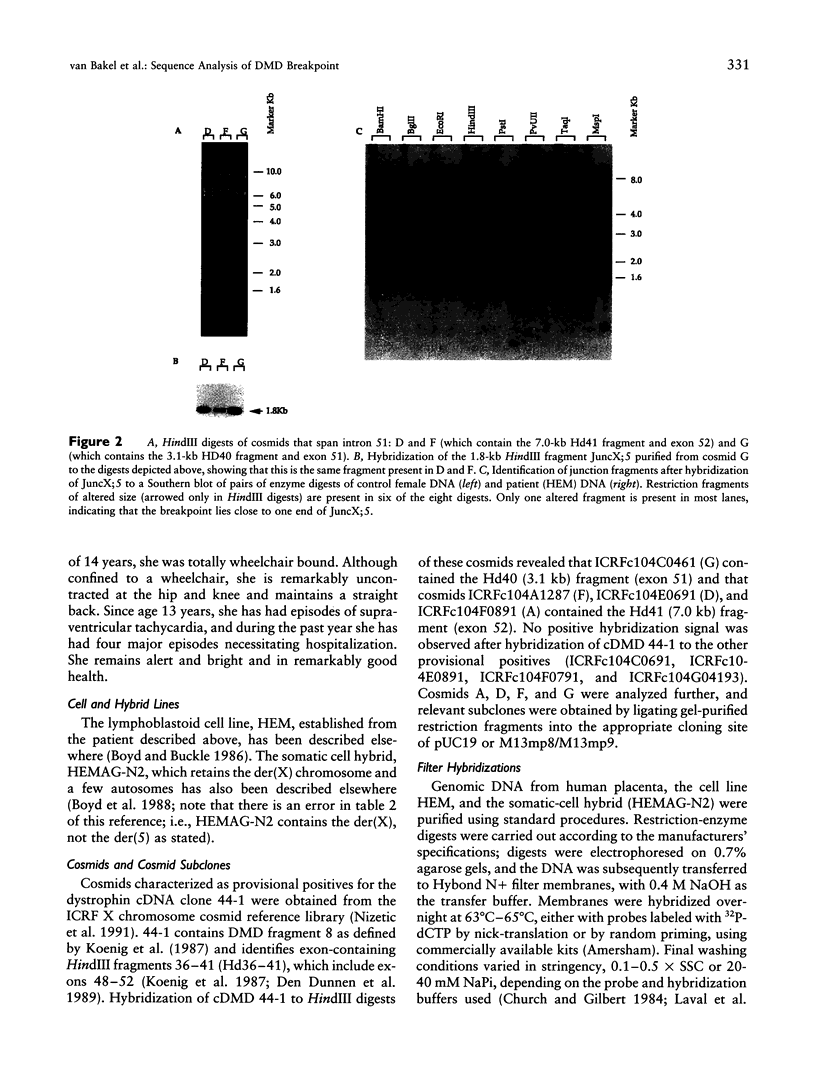
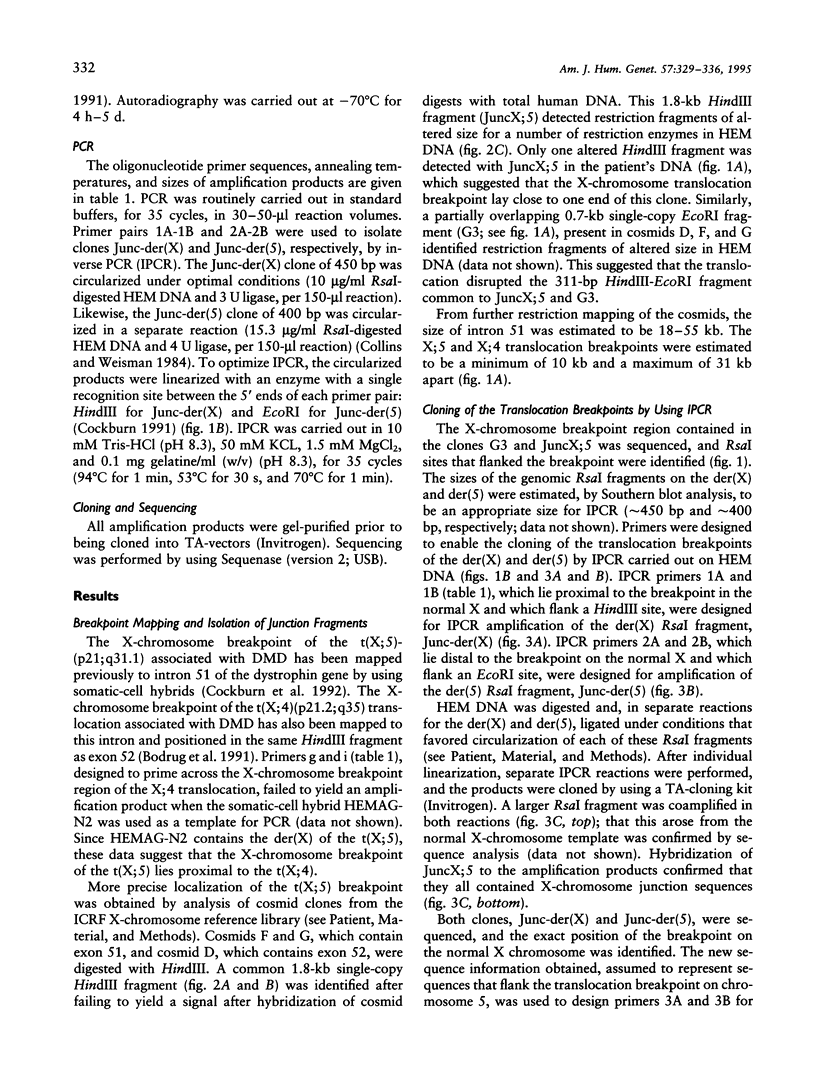
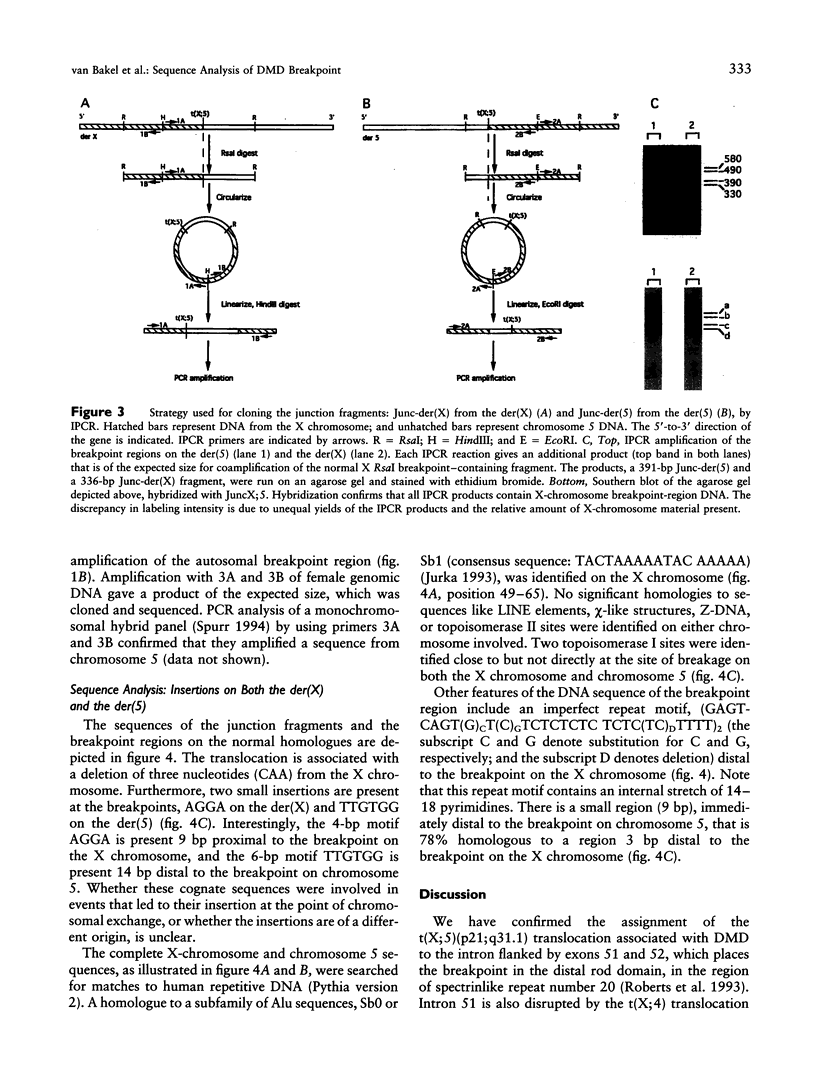
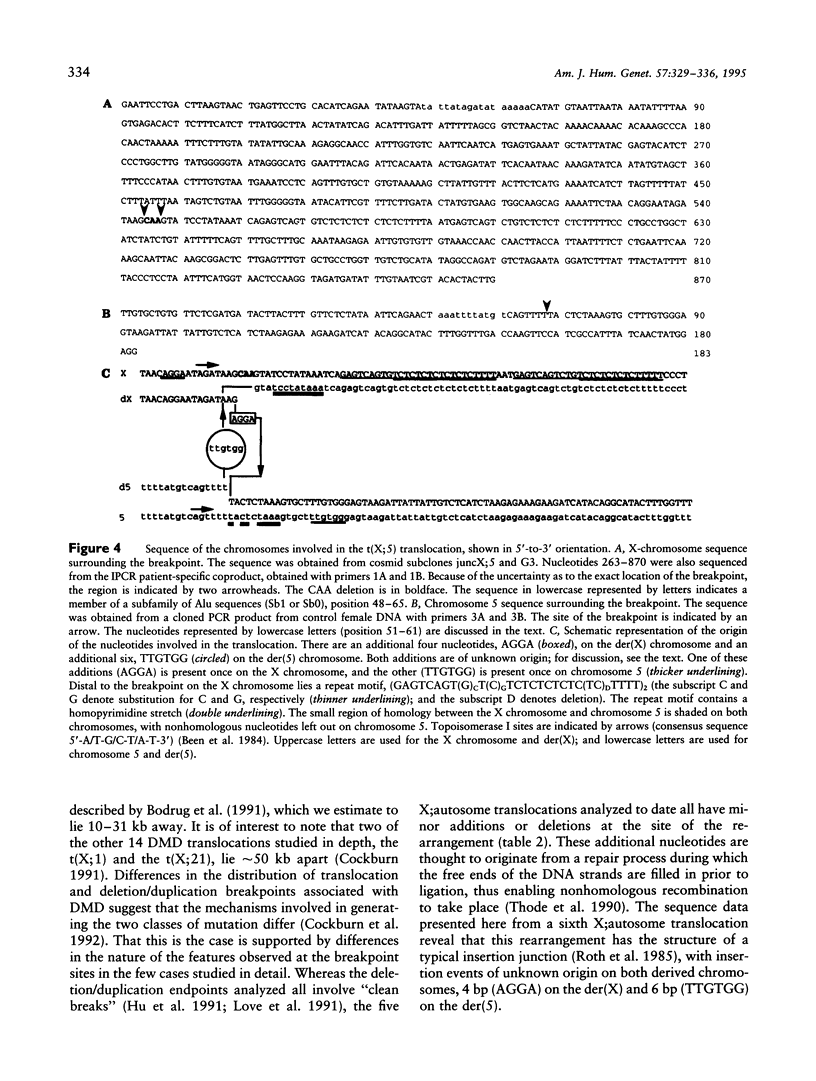
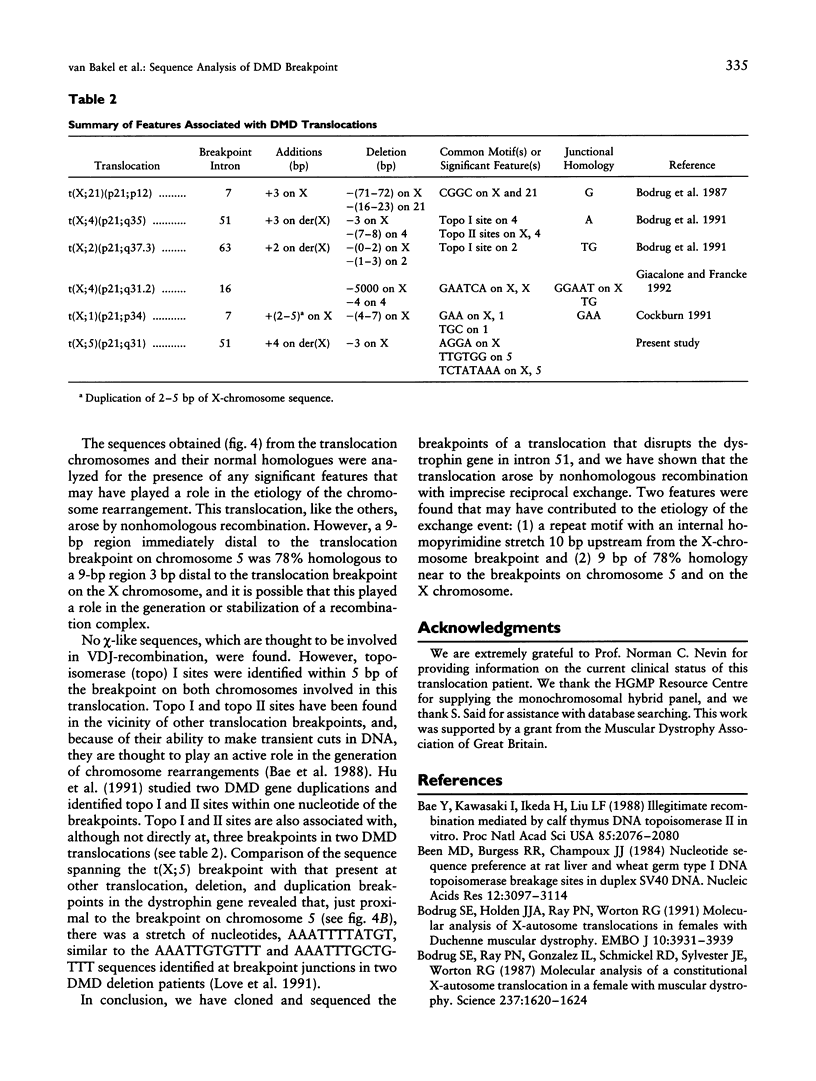
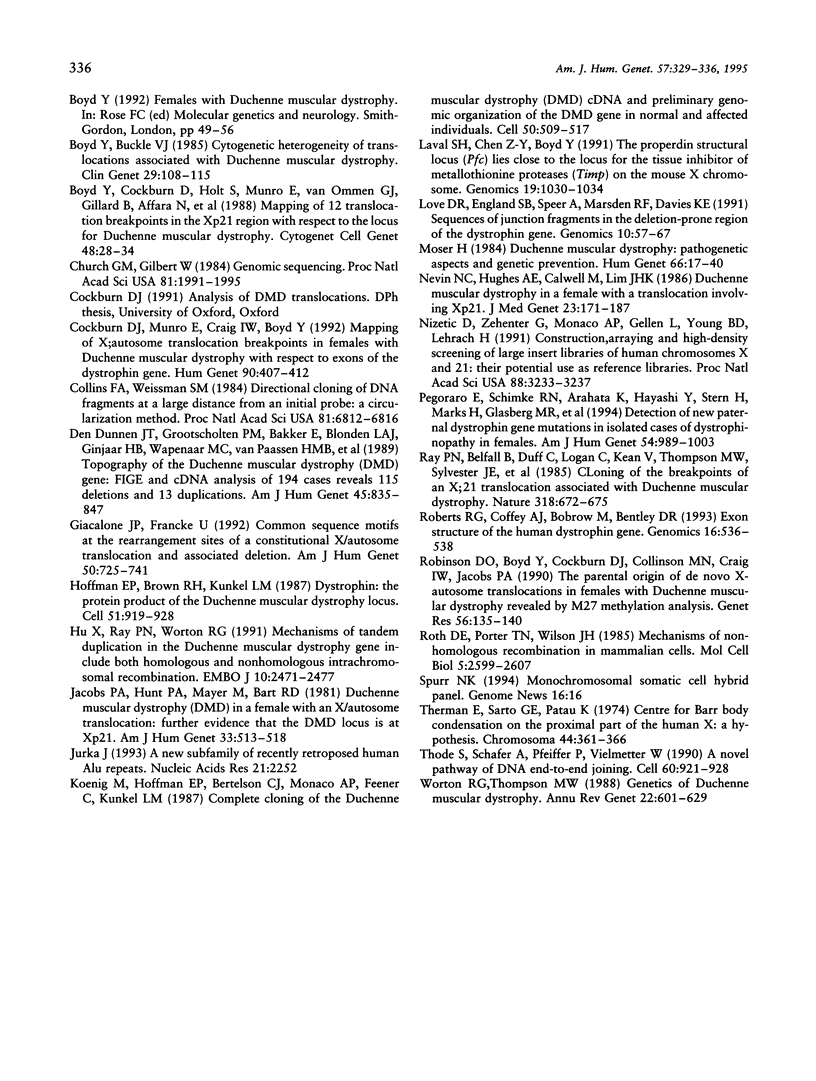
Images in this article
Selected References
These references are in PubMed. This may not be the complete list of references from this article.
- Bae Y. S., Kawasaki I., Ikeda H., Liu L. F. Illegitimate recombination mediated by calf thymus DNA topoisomerase II in vitro. Proc Natl Acad Sci U S A. 1988 Apr;85(7):2076–2080. doi: 10.1073/pnas.85.7.2076. [DOI] [PMC free article] [PubMed] [Google Scholar]
- Been M. D., Burgess R. R., Champoux J. J. Nucleotide sequence preference at rat liver and wheat germ type 1 DNA topoisomerase breakage sites in duplex SV40 DNA. Nucleic Acids Res. 1984 Apr 11;12(7):3097–3114. doi: 10.1093/nar/12.7.3097. [DOI] [PMC free article] [PubMed] [Google Scholar]
- Bodrug S. E., Holden J. J., Ray P. N., Worton R. G. Molecular analysis of X-autosome translocations in females with Duchenne muscular dystrophy. EMBO J. 1991 Dec;10(12):3931–3939. doi: 10.1002/j.1460-2075.1991.tb04963.x. [DOI] [PMC free article] [PubMed] [Google Scholar]
- Bodrug S. E., Ray P. N., Gonzalez I. L., Schmickel R. D., Sylvester J. E., Worton R. G. Molecular analysis of a constitutional X-autosome translocation in a female with muscular dystrophy. Science. 1987 Sep 25;237(4822):1620–1624. doi: 10.1126/science.3629260. [DOI] [PubMed] [Google Scholar]
- Boyd Y., Buckle V. J. Cytogenetic heterogeneity of translocations associated with Duchenne muscular dystrophy. Clin Genet. 1986 Feb;29(2):108–115. doi: 10.1111/j.1399-0004.1986.tb01232.x. [DOI] [PubMed] [Google Scholar]
- Boyd Y., Cockburn D., Holt S., Munro E., Van Ommen G. J., Gillard B., Affara N., Ferguson-Smith M., Craig I. Mapping of 12 translocation breakpoints in the Xp21 region with respect to the locus for Duchenne muscular dystrophy. Cytogenet Cell Genet. 1988;48(1):28–34. doi: 10.1159/000132581. [DOI] [PubMed] [Google Scholar]
- Church G. M., Gilbert W. Genomic sequencing. Proc Natl Acad Sci U S A. 1984 Apr;81(7):1991–1995. doi: 10.1073/pnas.81.7.1991. [DOI] [PMC free article] [PubMed] [Google Scholar]
- Cockburn D. J., Munro E. A., Craig I. W., Boyd Y. Mapping of X chromosome translocation breakpoints in females with Duchenne muscular dystrophy with respect to exons of the dystrophin gene. Hum Genet. 1992 Dec;90(4):407–412. doi: 10.1007/BF00220468. [DOI] [PubMed] [Google Scholar]
- Collins F. S., Weissman S. M. Directional cloning of DNA fragments at a large distance from an initial probe: a circularization method. Proc Natl Acad Sci U S A. 1984 Nov;81(21):6812–6816. doi: 10.1073/pnas.81.21.6812. [DOI] [PMC free article] [PubMed] [Google Scholar]
- Den Dunnen J. T., Grootscholten P. M., Bakker E., Blonden L. A., Ginjaar H. B., Wapenaar M. C., van Paassen H. M., van Broeckhoven C., Pearson P. L., van Ommen G. J. Topography of the Duchenne muscular dystrophy (DMD) gene: FIGE and cDNA analysis of 194 cases reveals 115 deletions and 13 duplications. Am J Hum Genet. 1989 Dec;45(6):835–847. [PMC free article] [PubMed] [Google Scholar]
- Giacalone J. P., Francke U. Common sequence motifs at the rearrangement sites of a constitutional X/autosome translocation and associated deletion. Am J Hum Genet. 1992 Apr;50(4):725–741. [PMC free article] [PubMed] [Google Scholar]
- Hoffman E. P., Brown R. H., Jr, Kunkel L. M. Dystrophin: the protein product of the Duchenne muscular dystrophy locus. Cell. 1987 Dec 24;51(6):919–928. doi: 10.1016/0092-8674(87)90579-4. [DOI] [PubMed] [Google Scholar]
- Hu X. Y., Ray P. N., Worton R. G. Mechanisms of tandem duplication in the Duchenne muscular dystrophy gene include both homologous and nonhomologous intrachromosomal recombination. EMBO J. 1991 Sep;10(9):2471–2477. doi: 10.1002/j.1460-2075.1991.tb07786.x. [DOI] [PMC free article] [PubMed] [Google Scholar]
- Jacobs P. A., Hunt P. A., Mayer M., Bart R. D. Duchenne muscular dystrophy (DMD) in a female with an X/autosome translocation: further evidence that the DMD locus is at Xp21. Am J Hum Genet. 1981 Jul;33(4):513–518. [PMC free article] [PubMed] [Google Scholar]
- Jurka J. A new subfamily of recently retroposed human Alu repeats. Nucleic Acids Res. 1993 May 11;21(9):2252–2252. doi: 10.1093/nar/21.9.2252. [DOI] [PMC free article] [PubMed] [Google Scholar]
- Koenig M., Hoffman E. P., Bertelson C. J., Monaco A. P., Feener C., Kunkel L. M. Complete cloning of the Duchenne muscular dystrophy (DMD) cDNA and preliminary genomic organization of the DMD gene in normal and affected individuals. Cell. 1987 Jul 31;50(3):509–517. doi: 10.1016/0092-8674(87)90504-6. [DOI] [PubMed] [Google Scholar]
- Laval S. H., Chen Z. Y., Boyd Y. The properdin structural locus (Pfc) lies close to the locus for tissue inhibitor of metallothionine proteases (Timp) on the mouse X chromosome. Genomics. 1991 Aug;10(4):1030–1034. doi: 10.1016/0888-7543(91)90194-j. [DOI] [PubMed] [Google Scholar]
- Love D. R., England S. B., Speer A., Marsden R. F., Bloomfield J. F., Roche A. L., Cross G. S., Mountford R. C., Smith T. J., Davies K. E. Sequences of junction fragments in the deletion-prone region of the dystrophin gene. Genomics. 1991 May;10(1):57–67. doi: 10.1016/0888-7543(91)90484-v. [DOI] [PubMed] [Google Scholar]
- Moser H. Duchenne muscular dystrophy: pathogenetic aspects and genetic prevention. Hum Genet. 1984;66(1):17–40. doi: 10.1007/BF00275183. [DOI] [PubMed] [Google Scholar]
- Nevin N. C., Hughes A. E., Calwell M., Lim J. H. Duchenne muscular dystrophy in a female with a translocation involving Xp21. J Med Genet. 1986 Apr;23(2):171–173. doi: 10.1136/jmg.23.2.171. [DOI] [PMC free article] [PubMed] [Google Scholar]
- Nizetić D., Zehetner G., Monaco A. P., Gellen L., Young B. D., Lehrach H. Construction, arraying, and high-density screening of large insert libraries of human chromosomes X and 21: their potential use as reference libraries. Proc Natl Acad Sci U S A. 1991 Apr 15;88(8):3233–3237. doi: 10.1073/pnas.88.8.3233. [DOI] [PMC free article] [PubMed] [Google Scholar]
- Pegoraro E., Schimke R. N., Arahata K., Hayashi Y., Stern H., Marks H., Glasberg M. R., Carroll J. E., Taber J. W., Wessel H. B. Detection of new paternal dystrophin gene mutations in isolated cases of dystrophinopathy in females. Am J Hum Genet. 1994 Jun;54(6):989–1003. [PMC free article] [PubMed] [Google Scholar]
- Ray P. N., Belfall B., Duff C., Logan C., Kean V., Thompson M. W., Sylvester J. E., Gorski J. L., Schmickel R. D., Worton R. G. Cloning of the breakpoint of an X;21 translocation associated with Duchenne muscular dystrophy. Nature. 1985 Dec 19;318(6047):672–675. doi: 10.1038/318672a0. [DOI] [PubMed] [Google Scholar]
- Roberts R. G., Coffey A. J., Bobrow M., Bentley D. R. Exon structure of the human dystrophin gene. Genomics. 1993 May;16(2):536–538. doi: 10.1006/geno.1993.1225. [DOI] [PubMed] [Google Scholar]
- Robinson D. O., Boyd Y., Cockburn D., Collinson M. N., Craig I., Jacobs P. A. The parental origin of de novo X-autosome translocations in females with Duchenne muscular dystrophy revealed by M27 beta methylation analysis. Genet Res. 1990 Oct-Dec;56(2-3):135–140. doi: 10.1017/s0016672300035217. [DOI] [PubMed] [Google Scholar]
- Roth D. B., Porter T. N., Wilson J. H. Mechanisms of nonhomologous recombination in mammalian cells. Mol Cell Biol. 1985 Oct;5(10):2599–2607. doi: 10.1128/mcb.5.10.2599. [DOI] [PMC free article] [PubMed] [Google Scholar]
- Therman E., Sarto G. E., Patau K. Center for Barr body condensation on the proximal part of the human Xq: a hypothesis. Chromosoma. 1974 Jan 29;44(4):361–366. doi: 10.1007/BF00284895. [DOI] [PubMed] [Google Scholar]
- Thode S., Schäfer A., Pfeiffer P., Vielmetter W. A novel pathway of DNA end-to-end joining. Cell. 1990 Mar 23;60(6):921–928. doi: 10.1016/0092-8674(90)90340-k. [DOI] [PubMed] [Google Scholar]
- Worton R. G., Thompson M. W. Genetics of Duchenne muscular dystrophy. Annu Rev Genet. 1988;22:601–629. doi: 10.1146/annurev.ge.22.120188.003125. [DOI] [PubMed] [Google Scholar]




